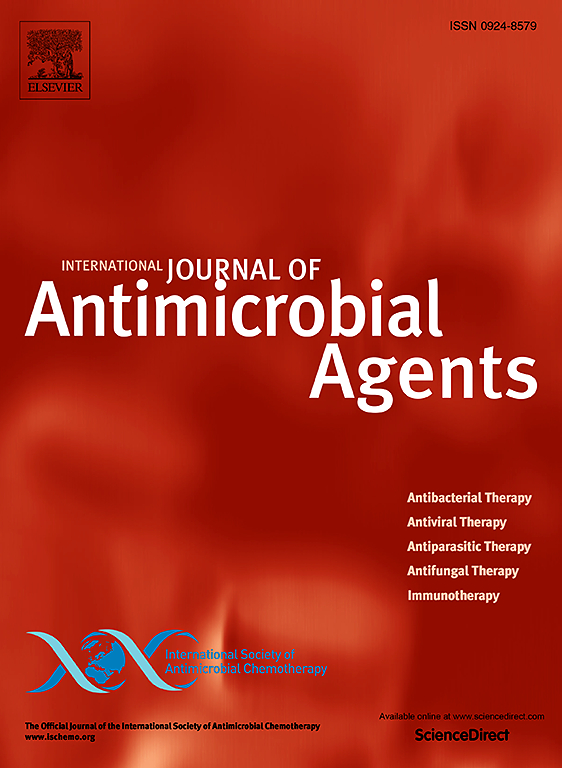Effects of different resistance mechanisms on bacterial response to meropenem, ciprofloxacin, and their combination described by next-generation mechanism-based modelling
IF 4.6
2区 医学
Q1 INFECTIOUS DISEASES
International Journal of Antimicrobial Agents
Pub Date : 2025-05-03
DOI:10.1016/j.ijantimicag.2025.107528
引用次数: 0
Abstract
Objective
This study aimed to investigate the effects of different bacterial resistance mechanisms on the response of isogenic strains of Pseudomonas aeruginosa to meropenem and ciprofloxacin, in monotherapy and combination.
Methods
Seven isogenic P. aeruginosa strains were used: the PAO1 wild-type reference parent strain, PAΔAD (AmpC overexpression), PAOD1 (OprD porin loss), PAΔmexR (MexAB-OprM overexpression), and strains with two of these mutations (PAΔDMxR, PAOD1MxR, PAOD1ΔD). Each strain was exposed to constant meropenem and/or ciprofloxacin concentrations over 72 h. Pharmacokinetic/pharmacodynamic indices, i.e. the percentage of time the free meropenem concentration exceeded the MIC of the pathogen (%fT˃MIC) and the ratio of the area under the free ciprofloxacin concentration-time curve over 24 h to MIC (fAUC/MIC), were calculated. A novel mechanism-based mathematical model was developed to describe the bacterial count profiles over time.
Results
The antibiotic exposures in monotherapy required to suppress regrowth varied between isogenic strains, even when strains had the same MIC; highlighting limitations of relying solely on MIC to inform dosing. Combination therapies, which cannot be predicted by pharmacokinetic/pharmacodynamic indices, were both synergistic and bactericidal at 72 h in five of the seven strains. All viable counts across all strains with monotherapies, combinations, and controls (n = 292 curves) were simultaneously modelled. The model accounted for different resistance mechanisms present across strains, while keeping all drug effect parameters the same between strains. The responses of strains with two resistance mutations were well described by the model developed from strains with a single mutation.
Conclusions
Overall, the mechanism-based mathematical model was predictive for >96% of treatments.

新一代基于机制的模型描述了不同耐药机制对细菌对美罗培南、环丙沙星及其组合的反应的影响。
目的:探讨不同细菌耐药机制对铜绿假单胞菌对美罗培南和环丙沙星单药及联合用药反应的影响。方法:采用7株等基因铜绿假单胞菌:PAO1野生型参考亲本菌株,PAΔAD (AmpC过表达),PAOD1 (OprD孔蛋白缺失),PAΔmexR (MexAB-OprM过表达),以及其中两种突变菌株(PAΔDMxR, PAOD1MxR, PAOD1ΔD)。每个菌株暴露于恒定的美罗培南和/或环丙沙星浓度超过72小时。计算药代动力学/药效学(PK/PD)指标,即游离美罗培南浓度超过病原菌MIC的时间百分比(fT - MIC)和24h游离环丙沙星浓度-时间曲线下面积与MIC的比值(fac /MIC)。开发了一种新的基于机制的数学模型(MBM)来描述细菌数量随时间的变化。结果:单药治疗中抑制再生所需的抗生素暴露量在等基因菌株之间存在差异,即使菌株具有相同的MIC;强调了仅仅依靠MIC来决定给药的局限性。联合治疗不能通过PK/PD指数预测,但在72h时,7株菌株中有5株既有增效作用,又有杀菌作用。同时对所有菌株的单一治疗、联合治疗和对照(n=292条曲线)的所有活菌计数进行建模。该模型考虑了不同菌株存在的不同耐药机制,同时保持菌株间所有药效参数相同。具有两个抗性突变的菌株的反应可以用单一突变菌株的模型很好地描述。结论:总体而言,MBM对bbb96 %的治疗有预测作用。
本文章由计算机程序翻译,如有差异,请以英文原文为准。
求助全文
约1分钟内获得全文
求助全文
来源期刊
CiteScore
21.60
自引率
0.90%
发文量
176
审稿时长
36 days
期刊介绍:
The International Journal of Antimicrobial Agents is a peer-reviewed publication offering comprehensive and current reference information on the physical, pharmacological, in vitro, and clinical properties of individual antimicrobial agents, covering antiviral, antiparasitic, antibacterial, and antifungal agents. The journal not only communicates new trends and developments through authoritative review articles but also addresses the critical issue of antimicrobial resistance, both in hospital and community settings. Published content includes solicited reviews by leading experts and high-quality original research papers in the specified fields.

 求助内容:
求助内容: 应助结果提醒方式:
应助结果提醒方式:


